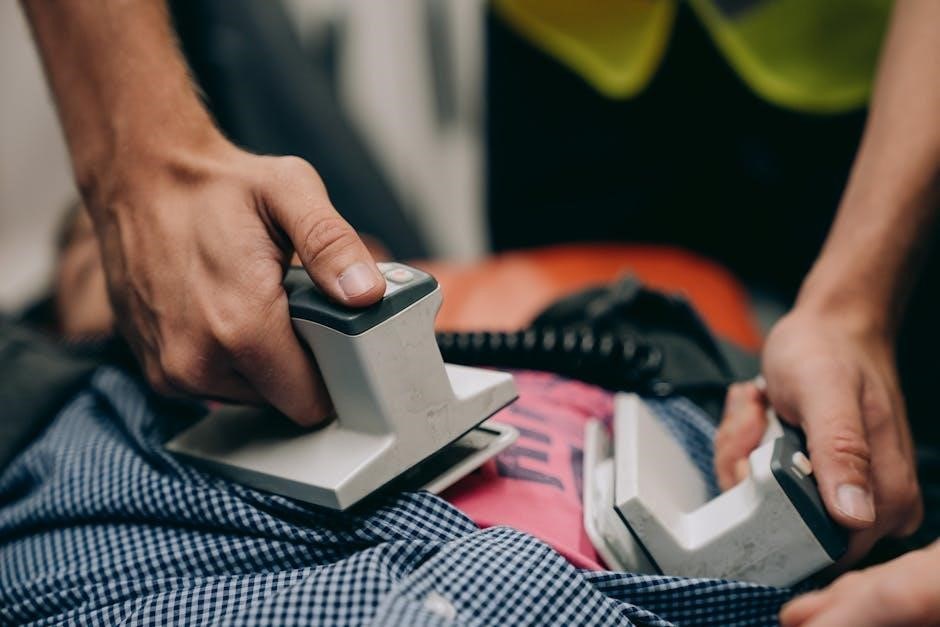Manual defibrillators are preferred for infants due to their adjustable energy levels, crucial for treating cardiac emergencies in this vulnerable population. Proper training is essential for effective use.
Importance of Defibrillators in Infant Cardiac Emergencies
Defibrillators are crucial in infant cardiac emergencies as they restore normal heart rhythms, preventing fatal outcomes. Manual defibrillators are preferred due to their adjustable energy levels, essential for infants’ smaller hearts. Proper training for healthcare providers ensures effective use, maximizing survival chances. When manual devices are unavailable, AEDs with pediatric attenuators can be used, though they may lack the precision of manual units. The ability to tailor energy delivery is vital, as infants’ physiological needs differ significantly from adults, making precise defibrillation critical for successful outcomes. Immediate intervention with appropriate devices is key to saving lives in such delicate situations.
Objective of the Article
This article aims to provide clarity on the use of defibrillators in infant cardiac emergencies, focusing on the preference for manual defibrillators. It explores the importance of defibrillators, their types, and clinical guidelines. The objective is to inform healthcare providers about the recommended practices, highlighting the differences between manual and automated devices. By analyzing evidence-based recommendations, this article seeks to equip professionals with the knowledge to make informed decisions. It emphasizes the critical role of proper training and equipment in improving outcomes for infants experiencing cardiac arrest, ensuring a comprehensive understanding of the topic.
Overview of Manual and Automated Defibrillators
Manual defibrillators require a trained operator to interpret heart rhythms and deliver shocks, offering precise control over energy levels. They are often equipped with infant paddles or pads for use on children under 1 year of age. Automated external defibrillators (AEDs) are user-friendly devices that analyze heart rhythms automatically and deliver shocks when necessary. Some AEDs include pediatric settings or pads, adjusting the energy dose for younger patients. While both devices are critical in emergencies, their operational differences make them suited for specific scenarios, particularly in infant cardiac arrest situations.

Recommendations for Infant Defibrillation
Manual defibrillators are preferred for infants under 1 year. If unavailable, use an AED with a pediatric attenuator. As a last resort, use an AED without one (Class IIb, LOE C).
Preferred Use of Manual Defibrillators for Infants Under 1 Year
Manual defibrillators are strongly recommended for infants under 1 year due to their ability to deliver adjustable, lower-energy shocks tailored to the infant’s size and condition. This customization minimizes potential harm and ensures effective treatment of life-threatening arrhythmias. Guidelines suggest starting with an electrical dose of 0.5 to 1 J/kg, which can be precisely controlled using a manual device. Trained healthcare providers should operate these devices, as they require expertise to assess heart rhythms and administer shocks accurately. If a manual defibrillator is unavailable, an AED with a pediatric attenuator is the next best option, followed by an AED without one as a last resort (Class IIb, LOE C).

Why Manual Defibrillators Are Recommended
Manual defibrillators are recommended for infants due to their customizable energy settings, which are critical for delivering safe and effective shocks. Unlike AEDs, manual devices allow healthcare providers to tailor the defibrillation dose precisely, reducing the risk of complications in newborns and young infants. This adjustability is vital because infants’ hearts are smaller and more sensitive, requiring lower energy levels to restore normal rhythms. Additionally, manual defibrillators often come with specialized infant paddles that fit their body size, ensuring proper contact and efficient energy delivery. This precision makes manual defibrillators the preferred choice for treating infants in cardiac emergencies.
Role of Automated External Defibrillators (AEDs) When Manual Defibrillators Are Unavailable
When manual defibrillators are unavailable, AEDs can serve as a critical alternative for treating infants in cardiac arrest. AEDs with pediatric attenuators or pads are preferred, as they adjust the energy dose to safer levels for infants; If an AED without these features is the only option, it may still be used, though with caution. AEDs are user-friendly and designed to guide rescuers through the process, making them a vital backup solution in emergencies. While not the first choice, AEDs can significantly improve an infant’s chances of survival when manual defibrillators are inaccessible.

Key Differences Between Manual and Automated Defibrillators
Manual defibrillators allow adjustable energy levels, ideal for infants, while AEDs provide automated, user-friendly operation but may lack customization without pediatric settings.
Customizable Energy Levels in Manual Defibrillators
Manual defibrillators offer adjustable energy levels, which are critical for infants. This customization ensures the shock is tailored to the infant’s size and condition, minimizing potential harm. The ability to set specific doses, such as 0.5 to 1 J/kg, is vital for their delicate physiology. Automated defibrillators, while convenient, often lack this precision without pediatric attenuators. For infants under 1 year, the manual device’s flexibility makes it the preferred choice, as it aligns with their unique physiological needs. This feature underscores the importance of skilled healthcare providers in delivering safe and effective care during cardiac emergencies.
Automated Functionality of AEDs

Automated external defibrillators (AEDs) are designed to analyze heart rhythms and deliver shocks automatically when needed. Their user-friendly interface makes them accessible to bystanders and less trained individuals. AEDs are programmed to recognize shockable rhythms, such as ventricular fibrillation, and provide a pre-set energy dose. For infants, AEDs with pediatric pads or attenuators are essential to reduce the energy level to a safer range. While AEDs are convenient, their automated nature limits customization, making them less ideal for infants compared to manual defibrillators. However, they remain a critical option when manual devices are unavailable, ensuring timely intervention in cardiac emergencies.
Situations Where AEDs Without Pediatric Attenuators May Be Used
AEDs without pediatric attenuators may be used in emergencies when neither a manual defibrillator nor an AED with pediatric capabilities is available. In such cases, the AED should be applied with caution, using adult pads if necessary. While not ideal, this approach ensures some level of intervention to address cardiac arrest in infants. However, the higher energy doses may pose risks, and providers must weigh the benefits of immediate action against potential harm. Training is critical to understanding these challenges and making informed decisions in high-stress situations. Manual defibrillators remain the preferred choice due to their customizable settings for infants.

Challenges in Treating Infant Cardiac Arrest
Challenges include infants’ unique physiology, requiring precise defibrillation, and the need for specialized training when manual defibrillators are unavailable.
Unique Physiological Characteristics of Infants
Infants have smaller heart sizes and unique physiological traits, requiring precise defibrillation energy levels. Their smaller body size and developing cardiovascular systems demand specialized care. Manual defibrillators are preferred as they allow adjustable energy delivery, crucial for infants’ sensitive hearts. Automated devices may not always provide the necessary customization, highlighting the need for trained healthcare providers to manage these emergencies effectively. Understanding these physiological differences is vital for optimizing treatment outcomes in infant cardiac arrest scenarios.
Importance of Proper Training for Healthcare Providers
Proper training for healthcare providers is critical when using defibrillators on infants. Manual defibrillators require precise operation, including accurate energy dose adjustment and electrode placement. Training ensures providers can quickly assess cardiac rhythms and deliver appropriate shocks. Misuse can lead to ineffective treatment or harm. Understanding both manual and automated devices is essential, as AEDs may be used when manual defibrillators are unavailable. Regular updates on guidelines and hands-on practice improve proficiency. Effective training enhances the ability to act decisively, maximizing the chances of successful resuscitation in infant cardiac emergencies. This expertise is vital for improving survival rates and outcomes in critical situations.

Manual Defibrillators vs. AEDs for Infants
Manual defibrillators are preferred for infants under 1 year due to customizable energy levels. AEDs with pediatric pads are alternatives when manual defibrillators are unavailable.
Advantages of Manual Defibrillators in Infant Care
Manual defibrillators offer precise control over energy levels, crucial for infants’ delicate physiology. They allow healthcare providers to deliver shocks tailored to the infant’s weight and condition, minimizing potential harm. Unlike AEDs, manual defibrillators enable synchronized cardioversion, reducing the risk of complicating the infant’s heart rhythm. Additionally, they often come with infant-sized paddles or hands-free pads, ensuring proper contact and safety; This customization and manual oversight make them the preferred choice for trained professionals in critical infant cardiac emergencies.

Limitations of AEDs in Infant Cardiac Emergencies
AEDs are less ideal for infants due to their inability to adjust energy levels, which may deliver shocks too powerful for their small bodies. Without pediatric pads, AEDs cannot attenuate the dose, potentially causing harm. Additionally, AEDs are designed for adults, making electrode placement on infants challenging and less effective. Their automated nature also limits customization, unlike manual defibrillators, which allow precise control. These limitations highlight why AEDs are secondary choices for infants, emphasizing the need for pediatric-specific equipment in such critical situations.

Clinical Guidelines and Evidence

Clinical guidelines recommend manual defibrillators for infants under 1 year due to their adjustable energy levels, supported by evidence emphasizing their superiority in pediatric cardiac emergencies (Class IIb, LOE C).
Class IIb, LOE C Recommendations for Infant Defibrillation
Class IIb, LOE C guidelines suggest manual defibrillators are preferred for infants under 1 year. If unavailable, AEDs with pediatric attenuators may be used, and as a last resort, adult AEDs without attenuators. These recommendations balance clinical evidence and practical availability, ensuring optimal outcomes in emergencies. They emphasize the importance of adjustable energy levels for infants’ unique physiology.
Studies Supporting the Use of Manual Defibrillators
Clinical evidence and studies emphasize the superiority of manual defibrillators for infants due to their customizable energy levels. Research indicates that manual devices allow precise dosing, aligning with the unique physiological needs of infants. These studies, supported by recommendations from authoritative bodies, highlight improved outcomes in cardiac arrest scenarios when manual defibrillators are used. The ability to tailor energy delivery ensures safer and more effective treatment, making manual defibrillators the preferred choice for infant cardiac emergencies. This evidence underscores the critical role of manual defibrillators in optimizing survival and neurological recovery for infants.
Manual defibrillators are recommended for infants due to their customizable energy settings, ensuring safer and more effective treatment in cardiac emergencies, as supported by clinical guidelines.
Manual defibrillators are preferred for infants under 1 year due to their customizable energy levels, which are critical for safe and effective treatment. Automated External Defibrillators (AEDs) may be used if manual defibrillators are unavailable, particularly with pediatric attenuators to reduce energy doses. Clinical guidelines, such as Class IIb, LOE C recommendations, support this approach. Proper training for healthcare providers is essential to ensure accurate assessment and appropriate use of these devices. This balanced approach maximizes survival chances while addressing the unique physiological needs of infants in cardiac emergencies.
Final Thoughts on the Use of Defibrillators for Infants
Manual defibrillators remain the gold standard for infants under 1 year due to their customizable energy levels, ensuring safer and more effective treatment. While AEDs with pediatric attenuators are a viable alternative, they should only be used when manual devices are unavailable. Proper training for healthcare providers is critical to navigate these life-saving tools effectively. Balancing device availability with provider expertise is essential to optimize outcomes in infant cardiac emergencies. Ultimately, the preference for manual defibrillators underscores the need for tailored approaches in neonatal care to address their unique physiological requirements.
